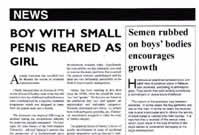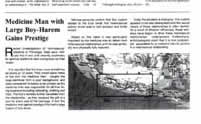Boy with small penis reared
as girl
A young American has revealed how he became the victim of scientific
experimentation.
Charlie Spencer born in Arizona in 1966, as one of a set of healthy
male twins has told reporters how his childhood and adolescence
were overshadowed by a rigorous treatment programme, which was designed
to transform the genital male into a female.
The treatment was imposed following an accident during his circumcision
whereby his penis was partially amputated. The biologist, Dr. John
Money of the John Hopkins University, advised Spencer’s parents
that the possession of a dysfunctional penis could be extremely
detrimental to the character development of the boy. Money recommended
that they rear the child as a girl, reassuring them that surgically
constructed female genitalia was far superior to the male equivalent.
He also explained that as the gender identity of the child remained
flexible until the age of 2 ½ years this would be a straightforward
procedure.
The young child was renamed and underwent surgical and hormonal
reassignment and his parents made a determined effort to socialise
him as a girl.
In this case the treatment failed, however. Spencer reveals his
unhappy and awkward childhood as a girl, when he was frequently
depressed and sometimes felt suicidal. He was always resistant to
hormonal and surgical treatment, and when his medical history was
eventually revealed to him, immediately opted for a reversal of
his gender reassignment. He is now well adjusted to his male gender
role awaiting advanced in surgical techniques before undergoing
a complete genital reconstruction.
Dr. John Money is generally regarded as the central figure in the
field of gender development research today. Significantly his own
articles on this particular case omit to mention the many problems
that occurred. His position remains unchallenged and his ideas are
very influential, particularly in the field of intersexuality management.
Money has been working in this field since the 1950s, when he coined
the terms ‘sex’ and ‘gender’ are independent
and malleable categories. Presently intersexual newborns, i.e. infants
born with ambiguous genitalia, are, if detected immediately assigned
to either the male of female category.
The apparent failure of Money’s theory of gender development
in cases of accidental genital amputation such as Spencer’s,
indicates the probable inadequacy of his intersexuality treatment
ideas. There are currently five recognised forms of intersexuality.
In one instance, children are chromosomally male, but possess a
“micropenis.” This can sometimes be treated with the
hormone androgen though the organ will not always be susceptible
to this hormone. Money recommends that in these cases it is preferable
for the child to undergo surgical reassignment into a female than
to grow up with a small penis.
Money’s treatment options reflect a paradoxical situation
in which society dictates biology. Infants are undeniably naturally
born with various combinations of male and female genitalia, however
physicians insist upon male and female as the only natural options.
Furthermore, though scientists are capable of determining the exact
chromosomal sex of an infant it is ultimately the aesthetic condition
of possessing an appropriately sized penis, which determines the
gender assignment.
Charlie Spencer’s case indicates that the current treatment
philosophy may be based on false assumptions and should now be re-examined.
|
|
Semen rubbed
on boys' bodies encourages growth
Homosexual practices between boys and adult men is commonplace
I Melanesian societies, according to anthropologists. They report
that such activity constitutes a normal part of every boy’s
childhood.
The nature of the practices vary between societies. In some cases
the boy performs oral sex on the man, in some he takes the receiver
role in anal intercourse and I others the semen of adult males is
rubbed onto their bodies. It is reported that a reversal of the
sexual roles, which could result in the loss of some of the boy’s
semen is considered damaging to the boy’s development.
The cultural belief that semen, like breast milk, is a fluid, which
encourages the growth process underlies these activities. Semen
is considered a scarce resource,e which contains the essence of
masculinity.
Melanesians think it does not develop spontaneously but has to
be introduced into the boys’ bodies in some way. The eventual
development of the boy into a man is taken as evidence for the validity
of their beliefs.
A comparison could be drawn between these activities and the benefits
of breast feeding, with the exception that human semen is never
replaced with a non-human variety.
The scientific basis of Melanesian customs is clearly unfounded,
and a similar situation in our culture would be categorised as institutionalised
child abuse. The boy’s do not seem to suffer any damage as
a result of this custom, as they grow into healthy men. Anthropologists
report that these societies are well-functioning.
This evidence clearly calls into question the basis of our own
notions about homosexuality, masculinity and child development and
exposes our beliefs as equally unfounded in science. |
|
Twins merge into 'Man-Woman'
in womb
Historians and Anthropologists have long reported of the occurrence
of transvestite and homosexual people in Native American Indian
societies. Recently new theories about ‘multi-gendered’
societies have shed new light on the nature of these individuals,
which has radical implications on basic assumptions made about gender
in our own culture.
There are few reason question the notion that there are only two
genders, man and woman, as this appears to be based in biology.
In view of recent cross-cultural investigation anthropologists imply
that a re-examination of the basis of Western gender culture may
be necessary as the existence of only two genders is arguable not
universal.
According to a Lakote shaman the ‘Great Spirit’ made
a two-spirit person alongside the creation of man and woman, as
he explained to an anthropologist: “We think that if a woman
has two little ones growing inside her, if she is going to have
twins, sometimes instead of giving birth to two babies, they have
formed up in her womb into just one half-man/half-woman kind of
being… To us a man is what nature or his dreams make him.
We accept him for what he wants to be. That’s up to him.”
Although biologists may dismiss these findings as unscientific,
such different gender-systems clearly challenge the basis of the
Western system. The research has shown that in some North American
Indian societies gender may be assigned according to the occupational
role preferred by an individual rather than the biological sex.
In some cases an individual is said to fluctuate between genders,
freely moving between male and female roles.
In these societies person’s assigned to the third or fourth
genders are often granted special privileges and shown great respect.
Today as a result of western preconceptions and the process of colonisation
the differently gendered individuals have largely disappeared. In
recent years with the growth of the lesbian, gay and transgender
movement in the United States the tradition has been experiencing
a revival as a young Indian homosexuals claim to be ancestors of
the two-spirit people |
|
Medicine Man with Large Boy-Harem Gains
Prestige
Recent investigations of ‘homosexual’ relations in Ponorogo,
East Java, indicate that it was until recently customary for spiritual
leaders to take young boys as their ‘wives’.
It is reported that the boys were sometimes as young as 12 years. They
would leave home to live with the medicine men. Usually the boys stemmed
from a poor background, and were considered fortunate to be chosen, as
the medicine man was responsible for all their living expenses including
schooling, clothing and food. The boy’s families further benefited
from the relationship, as they received the gift of a cow for every year
of the marriage. In turn the medicine man gained prestige if he had a
large harem of boy-wives.
Witness accounts confirm that this custom related to the local belief
that heterosexual activity would lead to ‘soft stomach and brittle
bones’.
Based on this belief it was particularly important for the medicine man
to refrain from heterosexual relationships until he was spiritually and
physically fully matured.
Today the situation is changing. The custom appears to be less widespread
and the sexual nature of these relationships is often denied. As a result
of Western influences, these societies have begun to drive these homosexual
relationships underground. Furthermore, anthropologists report that it
is now occasionally acceptable for a medicine man to partake in a heterosexual
relationship.
|






